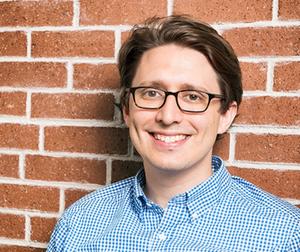 |
|
| Photo: Jason Roth Photography | |
Journalist David K. Randall is the author of Dreamland: Adventures in the Strange Science of Sleep and The King and Queen of Malibu: The True Story of the Battle for Paradise. His third book, Black Death at the Golden Gate: The Race to Save America from the Bubonic Plague, coming May 7, 2019, from W.W. Norton, recounts a dangerous episode in America's medical history. At the turn of the 20th century, San Francisco faced an outbreak of bubonic plague that was exacerbated by racist attitudes and pseudoscience. The hero of the book is a federal health officer named Rupert Blue who eventually succeeded in containing the disease, potentially saving millions of lives.
I imagine many people have never heard of the story you cover in the book. What lead you to it?
The fact that few people know that the bubonic plague once threatened to kill millions of Americans is one of the things that drew me to the story. I grew up in California and once lived in the Bay Area, but I still had never heard of it until I was working on my last book, The King and Queen of Malibu. I uncovered a letter written by one of the main characters in that story that called San Francisco the wickedest place that he had ever seen. That piqued my interest into what was happening in the city at the time, and I soon discovered newspaper articles calling Joseph Kinyoun a fraud for insisting that there was plague in Chinatown and that the whole country was in danger. It was such a pivotal moment not only in the number of lives threatened by the disease, but because of all the issues surrounding it--a fight over federal versus local power, racism, immigration and the inability of scientists to communicate the scale of danger to the public--that are still with us today.
The outbreak's initial discovery in Chinatown fed into widely held racist preconceptions. How did racism influence the response to the outbreak?
One of the things that made the outbreak of plague seem so relevant to today is how much racism and a backlash against immigration was a driving factor in the story. Asian-Americans in California at the time faced widespread bigotry, due in part to pseudo-scientific theories that held that Asians were a less advanced "race." At the same time, this was just a generation or so after the Gold Rush, and white men in California were for the first time facing a future in which sudden wealth did not seem right around the corner. Anti-immigrant groups like the Workingmen's Party harassed and attacked Asian-American workers, with the leader of the party, Dennis Kearny, often ending his speeches with the invective "The Chinese Must Go."
Into that powder keg you had an outbreak of a terrifying disease in a population that was widely thought of as being unsanitary. The threat of the disease soon became an excuse to implement racist measures like a quarantine of Chinatown and a travel ban that specifically targeted Asian Americans, regardless of where they lived or whether they were exposed to plague. The white population of San Francisco refused to take the plague threat seriously because so-called experts claimed that those with European ancestry could not become infected, allowing the disease to continue to spread. It was only when the disease broke out in majority-white neighborhoods of the city that San Francisco finally confronted the danger it was in.
How did you go about re-creating the lives of relatively obscure people, like plague victim Yuk Hoy? Was it important that you treat victims of the disease like individuals?
I was fortunate to be able to draw from scholarship that focused on the plague outbreaks in Honolulu, San Francisco, Los Angeles and New Orleans, as well as local records, the annual reports of the Public Health Service and materials from the National Archives that together provided some basic biographical aspects like the age, occupation and last known address of each victim. I only wish that I could have had more. Most of the Chinese American victims were poor and illiterate, leaving few records like letters or diaries that would have given more insights into their day to day lives. Treating each victim with dignity seemed like one small way to show that the population of Chinatown was not just the faceless bloc that the press and politicians at the time often treated it as, but instead a community of people whose lives were upended and cut short by a disease that they could not defeat on their own.
Some of Blue's methods of combating the plague seem surprisingly commonsense. Do you think we take for granted the great advances in hygiene in American cities?
One of the things I'm always fascinated by is how the world transitioned into what we recognize as the modern age. Many of those amazing jumps in human progress --the invention of the telephone, the recognition that germs cause disease, the use of electric lights in homes, the development of high-speed long-distance travel like the transcontinental railroad--all came during the lives of one generation that spanned roughly the end of the Civil War to the start of World War I. Blue's focus on hygiene was just one of the revolutions taking place in America at the time, and it directly influenced how we conceive of life as something that should be long and meaningful. Before, hygiene didn't seem all that important because there was little understanding of how germs spread disease. Blue's work in stopping the spread of plague in San Francisco through what now seem like commonsense means--chiefly, making the city less hospitable to rats--was a powerful demonstration that sanitation could save and extend lives. At the time, an abundance of rats was an accepted part of living in a city largely because it had always been that way and no one knew the extent to which they spread disease.
The book ends with a somewhat ominous note about the disease's continued existence in rodent populations throughout the West. Are you concerned that a drug-resistant version of the disease might again prove a major threat? Would we turn again to Blue's methods?
Plague continues to be a major threat. Though it's considered an ancient disease on a human scale of time, the bacteria that causes the plague is only about 3,000 years old, making it still very early in its evolution. While we currently have drugs that can combat it, the disease could easily mutate to the point where those drugs offer less and less resistance. At the same time, climatic change is contributing to outbreaks of the plague in places like Algeria and Angola where it has not been historically found, increasing the chances of human transmission. Blue's breakthrough was focusing his efforts on the rats that spread the disease rather than punishing the people who contracted it, and if there is another major outbreak-- whether by chance or by bioterrorism--we would likely continue in his footsteps. --Hank Stephenson

